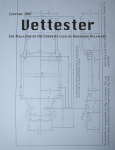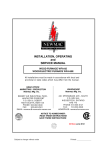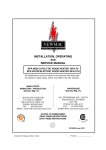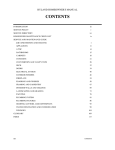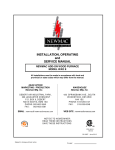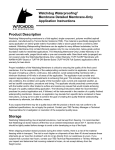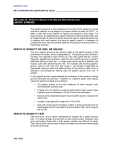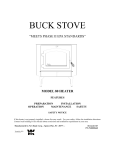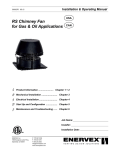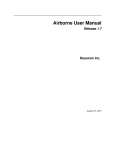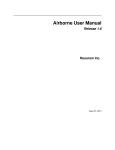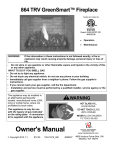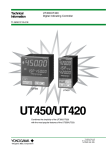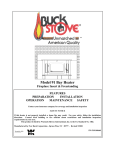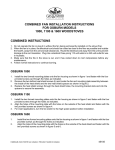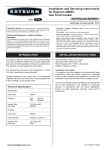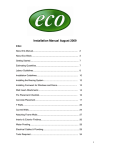Download Homeowner`s Guide to Chimneys, Fireplaces and Woodstoves
Transcript
1 The Homeowner’s Guide To CHIMNEYS, FIREPLACES AND WOODSTOVES Written By: JIM BREWER & ASHLEY ELDRIDGE 2 COPYRIGHT 1990—2003 By: James P. Brewer and Ashley H. Eldridge United States Copyright Office Registration number TX 2 847 356 1st Edition 1990 2nd Edition 1996 3rd Edition 2003 All rights reserved. No part of this book may be reproduced or transmitted in any form or by any means, electronic or mechanical, including photocopying, recording or by any other information storage and retrieval system, without permission of the authors. 3 Table of Contents Introduction ................................................... 4 Starting Your Fire ......................................... 5 Fireplace Construction .................................. 7 Chimney Caps ............................................... 10 Fireplace Accessories.................................... 12 Gas Logs ....................................................... 15 Woodstoves ................................................... 16 Woodstove Testing ....................................... 18 Woodstove Accessories ................................ 20 Moving The Heat .......................................... 22 Types Of Chimney Deposits ......................... 24 Removing Chimney Deposits ....................... 24 Creosote Buildup .......................................... 26 Chimney Fires ............................................... 28 Chimney Inspections ..................................... 29 Chimney Repairs ........................................... 31 Fuels .............................................................. 36 Buying Wood ................................................ 39 Wood Storage................................................ 40 Fire Safety Products ...................................... 43 Trouble Shooting Guide ................................ 44 House Stack Effect ........................................ 52 Wind Loading ............................................... 54 Chimney Odors ............................................. 55 Chimney Stains…………………………… 56 4 Introduction The intent of this book is to provide you, the reader, with information that will allow you to be more comfortable with your fireplace, gas logs, or woodburning stove. General information about the chimney is included as well. It is the wish of the authors that this additional information will give you the confidence that will allow total enjoyment of your fireplace or woodstove. In order to maximize your enjoyment of your fireplace or woodstove several things are required: The first, and most important step in this process is to determine that everything is properly installed and safe to operate. Without this assurance you could never be fully at ease and able to enjoy your fire without reservation. The second factor needed in order to fully enjoy your fire is the knowledge that you have the proper information. The authors of this book have over forty years of experience in this relatively new industry. Their experience has led to the recognition that most questions are very common and that there is a lot of homespun misinformation around. This book is not an attempt to sell you anything but will hopefully provide you with peace of mind and the ability to enjoy your woodburning stove, gas hearth appliance or open fireplace with confidence. 5 Starting Your Fire Building a fire in your fireplace or woodstove requires the use of tinder, kindling and firewood. Always remember, before actually lighting the fire check to be sure the damper is fully open. The key to building a fire is to think small. Starting your fire requires the use of tinder and kindling. The tinder should easily ignite with a match and begin burning. It will then ignite the kindling followed in turn by the larger logs. Newspaper makes good tinder. Good kindling would be small dry sticks and branches, the dryer the better. Kindling should not be more than an inch in diameter. We will describe below two different methods for starting a nice fire in your fireplace or woodstove. Conventional fire building - To lay the fire, arrange two small to medium size pieces of wood on the grate, about six inches apart. Place some crumpled up newspaper (tinder) between them and then cover the tinder with several pieces of kindling. Don't scrimp on the kindling as this is the most important part of starting the fire. Now put one or two more pieces of firewood atop the other logs. If you use two pieces, lay them at right angles to the first two. Be sure to leave enough space between them to allow good air circulation around the logs. Now light the tinder and within a few minutes you will have a nice, hot, roaring fire. Top down burn - Arrange three large, dry logs in your firebox and place them up to six inches apart depending on firebox size. Place them in the fireplace the long way front to back, not across, to provide good airflow for complete combustion. Place three more pieces of dry wood that are slightly smaller across the tops of the larger pieces, log cabin 6 style. Continue building this structure with increasingly smaller pieces of dry wood. The structure can rise until it is about two-thirds of the way to the top of your firebox. Aim for as many different sized levels as possible. Important: The top half of the log pile should be made up of small, branch and twig sized pieces of dry wood. Top the pile with kindling or wood shavings. When the dry kindling and shavings ignite, the fire will work its way down to the larger pieces, provided the wood is dry. Regardless of the method you choose, follow these three steps before lighting your fire: Insure that the fireplace damper is open. Twist up a sheet of newspaper and light it, holding it as high up in the fireplace as is reasonable. This will allow heat to rise up the chimney quickly and establish a good draft. Be careful not to burn yourself! Once the smoke is being drawn up the chimney, slowly move the burning paper down and use it to ignite the kindling. As the logs burn, add more firewood as needed. Be careful not to add too much wood. In a fireplace keep the top of the flames visible below the fireplace opening. In a woodstove, keep the flames confined to the woodstove itself. Flames roaring up into the chimney could start a chimney fire. Commercial fire starters are also available and work well. They eliminate the need for tinder and reduce the amount of kindling required. These products are sold in small packets or blocks and ignite easily. Never use liquid fire starters, such as charcoal lighter fluid or other flammable liquids indoors as this is extremely dangerous. At the end of the evening the fire should not be allowed to "smolder" out because this creates creosote buildup in the chimney. When you are through enjoying the fire, separate the logs by moving them to the side of the fireplace or standing them on end in the back of the fireplace. Close the screen or glass doors tightly. This will reduce the amount of air flowing up the chimney while the damper is open. Do not close the damper until you are sure the fire and coals are completely out. 7 Fireplace Construction Modern fireplace construction usually falls into one of two groups, masonry or factory-built. Masonry fireplace construction consists of hand laid brick or stone built on-site. Masonry has been the standard for fireplace construction for hundreds of years, and it lends a sense of quality and permanence to the structure. Many homeowners feel that masonry chimneys are indestructible, but, in fact, they are not. Masonry chimneys are frequently damaged by chimney fires, lightning strikes, or settling of the foundation. Masonry chimneys can also be damaged by a natural aging process resulting in deterioration of bricks and mortar accelerated by water absorption and deposits of acids found in the combustion byproducts of some fuels. Factory-built fireplaces and chimneys have gained popularity in newer homes because both the material and installation costs are generally lower than for masonry fireplaces. Factory-built units are often referred to as "zero-clearance" or "prefab" units. When properly installed, these units are safe and some models are very efficient. It should be understood that they will not last as long as a masonry fireplace and depending on quality, use, and location should be expected to last twenty to forty years before requiring replacement. Whether your fireplace and chimney is masonry or factory-built has little to do with the countless hours of enjoyment you can gain from using it. The keys to safe and enjoyable fireplace use are proper construction followed by appropriate maintenance and operation. Many variations of fireplace design are available and your choice may be influenced by local or regional emission requirements. Many areas of the country require low emission certification for fireplaces and woodstoves. Rumford style fireplaces and masonry heaters are two types being used because of their ability to reduce emissions and provide increased efficiency in heating. Additionally, local building code requirements may effect the design of your fireplace, such as requiring an outside air source for your fireplace or additional reinforcement in earthquake prone areas. 8 A Typical Masonry Fireplace MORTAR CROWN FLUE CEILING SMOKE CHAMBER MANTLE SMOKE SHELF LINTEL HEARTH DAMPER FIREBOX ASH DUMP FOUNDATION CLEAN OUT DOOR FOOTING 9 A Factory-Built Fireplace CHIMNEY CAP CHASE COVER FIRESTOP CHIMNEY FIREPLACE HEARTH 10 Chimney Caps It has been said a chimney without a cap is like a house without a roof. Imagine how much water would come into your home during a rainstorm if you had a hole in your roof twelve inches square. Chimney flues may be even larger than that, so where does all that water go? It runs down the chimney and seeps into the bricks and mortar, settling behind the firebricks in the fireplace. There is little air circulation in the chimney (unless you're using it) and no sunlight, so the inside of the chimney stays wet long after the rain stops. This moisture erodes the mortar joints and weakens the brick. Add to this a freeze/thaw cycle during the cold months, and you have all the needed ingredients for a deteriorating chimney. Take our word for it: even though you can't see the damage happening, it's there, slowly deteriorating your beautiful fireplace and chimney. This is a particularly important consideration if you have a metal firebox incorporating a metal damper and smoke shelf. All fireplace dampers made of metal are subject to this deterioration as the water mixes with creosote and mild acids are formed. Even chimneys serving woodstoves are in need of a cover. Listed below are several good reasons to have a chimney cap: Keep out rain, snow and sleet. Keep out animals and birds. Keep out leaves, twigs and other debris which could lead to a blockage or chimney fire. Keep sparks from leaving the chimney and igniting nearby combustibles. Help eliminate wind induced downdrafts. 11 Chimney caps are made from a variety of materials. The most common are galvanized, stainless steel, and copper. Caps made of stainless steel and copper will last much longer than those made of regular galvanized steel and they normally carry an extended warranty. Spending a little extra for a good quality chimney cap will be money well spent and there will be no danger of rust staining the chimney. A Typical Chimney Cap 12 Fireplace Accessories Many products are available that will help you improve the safety, efficiency and convenience of your fireplace. Several of the more common items are described in this chapter. SPECIAL NOTE - Professional installation is recommended for any type of heating equipment, including fireplace accessories. If your fireplace is a factory-built or "prefab" unit, be sure to use only products approved or recommended by the manufacturer of the fireplace. Using non-approved products can have a serious effect on the safety of your fireplace. Glass doors - Glass doors perform several functions. The most obvious change is to improve the appearance of your fireplace. A glass door also helps reduce heat loss from your home, both during and after the fire. Most glass doors have a mesh screen built in that will prevent sparks and embers from popping out of the fireplace. Be sure to close the screen while the fire is burning. If you don't have a blower, you will want to leave the doors open to get the greatest possible amount of heat out of the fireplace. After you are through enjoying the fire, separate the logs so they will burn out quickly and then close the doors. This will stop heat loss from the home while the ashes are cooling down. Blowers - There are many types of blower units that can be added to most fireplaces. The use of a blower can improve the overall efficiency of your fireplace and supplement your home's heating system. If your fireplace has a blower system, it may be appropriate to operate the fireplace with the doors closed. In this manner the glass doors will prevent room air from escaping up the chimney while the blower pushes the heated air out of the fireplace. Note: Do not burn the fireplace with the doors closed unless the manufacturer of the door recommends this. Some glass doors may not withstand the high temperatures produced. 13 Grates - A grate is so important it should not really be considered an accessory because every fireplace needs a grate to burn properly. Be sure to select the proper size grate for your fireplace. Most people tend to purchase the largest grate that will fit into the fireplace, but this is not recommended. Select a grate that is approximately two-thirds the width of your fireplace and half the depth for best results. Dampers - Like grates, a damper is really a "must item" for a fireplace. Without the damper a great deal of heat will be lost up the chimney when the fireplace is not in use. The normal alternative to a damper would be a set of tight fitting glass doors. A damper can also be used to control the flow of smoke and heat up the chimney. By careful experimentation you can find the minimum damper opening for various fire conditions. Always have the damper in the fully open position when starting your fire. Once the fire is established you can gradually decrease the damper opening. Make these adjustments slowly and allow the fire time to stabilize between adjustments. If any smoke or odors escape into the room, the damper is not open enough. Pay close attention to the damper setting as varying fire conditions will require different damper settings. For example, as the fire dies down, more smoke will be generated and a greater damper opening will be required. Damper opening requirements will also vary according to outside temperature and other atmospheric conditions. With all of that said, probably the best thing to do is to leave the damper completely open whenever using the fireplace. While most dampers are located in the throat of the fireplace, there are dampers that are attached to the top of the chimney. Top mounted dampers are operated by a control mounted in the firebox and connected to the chimney top damper by a cable or chain. Chimney top dampers are often an economical alternative to replacing a throat damper. Top mounted dampers will also keep rain and animals out of your chimney when in the closed position. 14 Screens - Another "must item" for a fireplace is a screen. If you do not have a spark screen for your fireplace, get one before you have your next fire. A spark screen prevents sparks and embers from jumping out of the fireplace. Many home fires have been started by sparks coming from a fireplace that has no screen. The screen may be a freestanding screen or one included with a glass fireplace door. Woodstoves - For those wishing to supplement their existing heat with woodburning, we recommend the purchase of a woodstove. For additional information see the section devoted to woodstoves. Firebacks - Cast-iron firebacks are very useful for radiating additional heat from an open fireplace, whether the fireplace burns wood or has gas logs installed. Most homeowners who have added a fireback to their fireplace report a dramatic improvement in heat output. A fireback is not recommended, however, as an alternative to repairing a damaged firebox. Quality - We feel it is worth saying a word about quality here. Most fireplace accessories are available in a wide range of style and quality.For example, glass doors are available with different glass thickness, different metals (plated brass vs. solid brass) and varying levels of quality. Fireplace grates can be made of thin steels that will burn out in a year or two, or they can be made from materials that will last a lifetime. Just like most other products, you get what you pay for! A few extra dollars will usually be well spent to get a product of higher quality. Shop carefully and compare prices and features. 15 Gas Logs Gas fireplace logs are becoming quite popular. Their convenience and cleanliness have convinced many woodburners to retire the chainsaw and log splitter. Gas logs may be fueled by either natural or propane gas. There are two basic types of gas logs currently on the market. The two types are the "vented" and the "unvented". Vented gas logs require a venting system while unvented gas logs are approved for use without a venting system. The vented gas log sets produce a very realistic and attractive fire. Quite often a vented log set will be mistaken for a real wood fire. The heat output from a vented log set will be similar to the heat output from a comparable sized wood fire. Vented gas logs generate soot and carbon which is deposited in the chimney. These deposits require chimney cleaning just like a real wood fireplace does. Unvented log sets are designed to provide much more heat output than a vented log set. While the unvented log sets are generally not as attractive as the vented type, they burn hotter and cleaner. Unvented or vent free gas logs may be approved for installation in a masonry wood burning fireplace or specific factory-built fireplaces with the damper closed. Manufacturers may also provide a separate firebox cabinet approved for installation without a chimney. Unvented gas logs should not be used as a primary source of heat because continuous use could cause air quality problems in the home. In addition to gas logs, several other gas products have been developed for fireplace use. Gas fired inserts have been designed to be installed in fireplaces. These gas inserts usually have a greater heat output than conventional gas logs and may resemble a wood burning insert. Gas fireplaces have also been developed for installation where no fireplace currently exists. These fireplaces are usually more economical to install than a woodburning fireplace and offer the convenience of gas as a fuel. Gas fireplaces and gas inserts could be vented, unvented, or direct-vent. Direct vent appliances draw all combustion air from outside the home and also discharge their exhaust, or flue gas, to the outdoors. Direct-vent appliances are ideal for use in homes which are so air-tight they cannot provide sufficient combustion air for the appliance. When installing any gas appliance consult the manufacturers installation instructions and local codes. The use of a qualified gas installer is recommended for the installation of your gas hearth appliance. 16 Woodstoves Woodstoves come in a variety of sizes, shapes, and styles. Some are basic designs, and others are very elaborate and, therefore, more expensive. Woodstoves are usually installed in one of the following three ways: Fireplace insert - Here a woodstove is installed partially or completely inside a fireplace, often with only the front portion of the stove exposed. Some designs do project out enough to provide a cooking surface and additional radiant surface area. Hearth stove - These stoves may be set on the hearth of the fireplace or on the floor in front with some type of floor protection. The fireplace opening or throat is usually sealed with a metal plate, and the stove is vented through the plate with a length of stovepipe. Many older installations simply have a sheet metal cover over the fireplace opening with a pipe venting into the firebox of the fireplace. This type of installation should be changed as soon as possible since it represents the least efficient installation from a performance standpoint and is potentially the greatest threat of a chimney fire. Call your chimney sweep and ask for recommendations. Freestanding - This stove is installed in the room with all of its sides completely exposed and connected to a chimney built specifically for the stove. The chimney may be of the factory built type or may be made of masonry. Many stoves on the market today can be installed in more than one of these methods. For example - most freestanding stoves can be installed as hearth stoves, and many insert stoves can be installed as freestanding stoves. We recommend the freestanding stove whenever possible; however, it has been our experience that most homeowners choose the insert or hearthstove. Freestanding stoves are more efficient because they are free to radiate heat on all sides. The exposed connector pipe from the 17 stove to the chimney will also radiate heat into the room. Properly installed freestanding stoves are generally easier to maintain than either an insert or a hearth stove. If you already have a fireplace, you can install an insert or hearth stove without putting up a new chimney. But beware, there are considerable drawbacks to this such as the potential for increased creosote deposits. Increased volume and glazed creosote deposits will mean more frequent and aggressive cleanings, often twice a year. Proper cleaning of the chimney requires that the stove be removed to provide access to the firebox and smoke chamber. Since these installations are harder to service and therefore represent greater expense, the homeowner tends to perform the required servicing less often, thereby creating a higher risk of chimney fires. Freestanding stoves are both more efficient and easier to maintain. Most freestanding woodstoves can be maintained by an able homeowner with only a few special tools. This ease of maintenance will lead to safer overall burning conditions. If you already have or plan to vent a fireplace insert or hearth stove into your fireplace chimney, we highly recommend installing a properly sized chimney liner from the woodstove to the top of the chimney. Keep in mind that your fireplace was designed to vent a large, hot fire with plenty of air reaching the fire. When you install either an insert or hearth stove into the fireplace, the burning characteristics of the fireplace change. Instead of the hot, open fire normally found in a fireplace you will generally have a slow smoldering fire in the woodstove. In addition, the typical fireplace flue is usually much larger than what the average woodstove requires, and this leads to greater cooling of the flue gases and high rate of creosote buildup. This buildup will often be in the form of a tarry creosote that is difficult to remove from the chimney and yet poses a serious fire risk. Because of these design considerations, it is unlikely you will be able to achieve the efficiency your heater is designed to provide without a liner from the stove to the top of the chimney. 18 There is one more type of stove that deserves a mention, and that is the pellet stove. A pellet stove is a special stove designed to burn small dense wood-like pellets. These pellets automatically feed from a hopper to the combustion chamber at a rate set by the operator. Pellet stoves are simple to operate. Typically they will burn a steady fire for 24-36 hours between fueling. Due to the very low emissions of pellet stoves they can be vented through the wall with a specialized vent. Pellet stoves are available as freestanding, hearth or insert stoves. Woodstove Testing Woodstoves currently being sold are required to undergo two types of testing; safety and emissions. Safety testing is performed by agencies such as Underwriter's Laboratories to determine if the stoves are safe when installed and operated according to the manufacturers recommendations. Emissions testing is required by the Environmental Protection Agency to determine if stoves can achieve an acceptable (low) level of particulate emissions. The requirement for emissions testing forced considerable design changes for stove manufacturers in order to pass the tests. These design changes have resulted in fewer stoves being produced. However, the approved stoves are cleaner burning and more efficient, but are also more expensive than earlier non-approved models. If you are planning to purchase a new woodstove, discuss safety and emissions testing with the dealer to determine if the stove you are considering has the required approvals. Getting a heater that is the proper size is important to your long term satisfaction and will provide the greatest potential for the stove to operate at peak performance. 19 A Freestanding Stove CHIMNEY CAP STORM COLLAR FLASHING PRE-FABRICATED CHIMNEY CEILING SUPPORT BOX 20 Woodstove Accessories Many items are available which will make your woodstove more enjoyable, more efficient, easier to operate, safer or any combination of the above. This chapter will describe some of the common woodstove accessories. Grates - A small grate or andirons will generally aid in starting and maintaining a fire in your stove. Consult the owners manual for your stove for recommendations concerning the use, type, and size of grate. The quality of the grate should be given consideration as woodstove grates are subjected to high temperatures for long periods of time. Note: Some woodstove manufacturers recommend that grates not be used in their stoves. Screens - A good quality screen is recommended for all woodstoves that can be operated with the doors in the open position. It is a good practice to burn this type of stove with the doors open for approximately 30 minutes each time you load the stove and for an hour at least once a day. This "open burning" helps control creosote buildup and reduce glazed creosote deposits. This practice is appropriate if used consistently and should only begin after a thorough chimney cleaning. Thermometers - A thermometer is a useful indication of stove performance. Two types of stove thermometers are available: Probe type - This type is for stovepipe and has a probe into the flue which provides an accurate measurement of flue gas temperature. The thermometer should be placed into the stovepipe as far from the stove as practical. Ideal flue gas temperatures would be between 400-900 degrees. Surface Mount Thermometers - These are available and can be used where probe type thermometers are impractical. A surface mounted thermometer will only indicate approximately 50% of the actual internal temperature. 21 Catalytic Combustors - A catalytic combustor is a device designed to be built into or added to a woodstove. Its purpose is to reduce the temperature required to consume the particulate in the smoke so that a large portion of the flue gases will be consumed prior to entering the chimney. When properly incorporated into the stove design, a catalytic combustor significantly improves the overall efficiency and reduces the emission of pollutants into the atmosphere. Retrofits, or "add-on" catalytic combustors for existing stoves are not always as successful due to variations in the stove design. Catalytic combustors need periodic replacement, usually after 5,000 to 10,000 hours of use. You will notice a marked decline in the performance of your stove as the catalytic combustor nears the end of its useful life. It will also be necessary to maintain the combustor by cleaning the grid periodically to allow proper flow and operation. This would be the time to inspect the combustor for damage. An important consideration when operating a stove with a catalytic combustor is "light-off". The catalytic combustor needs to be preheated to approximately 750 degrees for 20 minutes before it is engaged or brought into the path of the flue gases. Failure to achieve a proper light off is the most common user error with catalytic combustors. Covered Ash Container - A metal can with a tight fitting lid is a very handy tool for removing ashes, hot or cold, from the fireplace or woodstove. Be sure to dispose of them very carefully as coals insulated in the ashes will stay hot for days. Be careful not to dispose of hot coals near the house and be especially cautious on windy days. If you have a dedicated area for ash disposal, such as your garden for example, you can wet the ashes to be sure they are completely out before leaving them. Gloves - Woodburners gloves are a necessity when operating a woodstove. Adding fuel to a wood stove can be a trying experience, resulting in burns, without this handy item. 22 Moving The Heat Hopefully your fireplace or woodstove will generate a lot of useful heat. Many times, though, homeowners experience an intolerable buildup of heat in the room where the fireplace or woodstove is located with little of it getting to the rest of the home. The natural circulation of this excess heat depends on many factors, as follows: Location of the chimney and stove - A centrally located chimney and stove will work better than a chimney at one end of the home. Interior chimneys will also radiate more heat into the home than a chimney which has three sides exposed to the cold outdoor temperatures. It also has the added advantage of staying warmer and not cooling the flue gases as rapidly. Design of the home - Open floor plans allow heat to seek out the cooler areas easier than floor plans with lots of walls, small doorways or other barriers. Windows and insulation - Large or multiple windows will allow abnormal amounts of heat to escape to the outdoors, as will poorly insulated walls. Multiple stories - Homes with more than one floor level allow the heat to rise to the upper floors, often to the point of making the first floor colder than desired. The items above are some of the factors that influence how well the heat will circulate. Unfortunately, most of those factors cannot be changed once the home is built. Let's look at some things that we can do to help improve the circulation of heated air. Place a fan at floor level blowing into the room with the woodstove or fireplace. Yes, we did say into the room. The cooler air will always be on the floor so you want to blow cooler air into the room which will cause the warmer air at ceiling level to come out and circulate to other rooms. If you have the fan blowing out of the room at floor level, you 23 will only pull cooler, floor level air out of the room. Install a "mini-fan" in the doorway of the room with the fireplace or woodstove. This fan should be blowing out of the room since it should be located up high where the warm air is. Registers or vents can be installed high in the wall between two rooms allowing the heat to flow from one room to another. These vents may also be installed in the floor allowing the heat to rise from one level to another. Stairways will act as natural chimneys allowing the warm air to rise to the upper levels of the house. Floor vents are not usually needed because the natural "stack-effect" in the home will allow the heat to rise. These vents may be purchased with or without "booster" fans to assist the natural air flow. "Booster" fans are recommended for through the wall vents but are generally not required for floor vents. When making changes of this sort the best results will be achieved when encouraging the natural convective cycle within the home. Ceiling fans can be used to help circulate the heat. They are not very effective for moving heat from room to room; but when installed in the room with the fireplace or woodstove, they will bring the hot air down from the ceiling and make the room more comfortable. Another method you may wish to try is running your heating system in the "fan only" position if it is so equipped. This will circulate the air in the home without running the heat portion of the system. This works well for some people but fails to impress others. 24 Types of Chimney Deposits Chimney deposits can be found in a variety of forms but can be divided into three basic types as shown below: Soot - Soot is primarily composed of carbon particles but may also contain ash. Soot has a soft texture and will be black or brown in color. The flammability of soot will depend on the concentration of soot and ash. Soot, since it is made of carbon, is combustible. Ash is noncombustible. Creosote - Creosote can be defined as a combustible deposit in the venting system which begins as condensed wood smoke including tar fogs and vapors. Creosote is a by-product of incomplete combustion. Creosote will be hard brown or black and form either curly, flaky deposits or even bubbly deposits in the venting system. Creosote is flammable. Glaze - Glaze is a form of deposit that presents itself as a shiny, tarry substance. Glaze can form puddles or drop down and make formations that resemble black icicles. Glaze is the most dense type of wood burning deposit and, therefore, represents the greatest amount of fuel to burn in the event of a chimney fire. Glaze is also the most difficult type of deposit to remove from the chimney. Removing Chimney Deposits Enter the chimney sweep! The main job of a chimney sweep is to remove chimney deposits and evaluate the overall condition of the venting system. A competent chimney sweep should be able to provide recommendations that will improve the safety and efficiency of your appliance and venting system. 25 There are several reasons to remove chimney deposits: To ensure that the appliance vents properly to the outdoors. To prevent chimney fires. To reduce or eliminate chimney odors. To remove blockages that could cause carbon monoxide gases to enter the home. To prevent deterioration of the chimney interior caused by acids in the deposits. There is no single answer for how often a chimney should be cleaned. The National Fire Protection Association (NFPA) recommends that chimneys be inspected at least once a year and cleaned as necessary. The required cleaning frequency will depend on amount of use, the type of installation, the type of fuel, and the burning habits of the operator. Chimneys should be cleaned when accumulations of soot and creosote approach or exceed 1/4 inch. Accumulations of glaze in excess of 1/8 inch should be removed. Frequent, at least annual, inspections are the only way to know when the chimney requires cleaning. Chimney sweeps employ a variety of cleaning techniques to remove chimney deposits. The method chosen or recommended for your chimney will depend on the type of deposits. Several cleaning methods are described below: Standard Cleaning - This is the standard or normal cleaning method and involves the use of brushes to clean the chimney walls. A powerful, well filtered vacuum is used to prevent soot and creosote from entering the home. This type of cleaning is effective for soot and ordinary creosote deposits but has little effect on glaze deposits. Mechanical Cleaning - Mechanical cleaning involves the use of wire brushes, plastic cables or special chains rotated at high speed by an electric motor. Mechanical cleaning is often employed to remove hard creosote or glaze deposits. Mechanical cleaning should only be attempted by professional sweeps familiar with the use of this type of equipment. The improper use of mechanical cleaning tools can be hazardous to the operator and the chimney. 26 Chemical cleaning - Some sweeps prefer to use chemical cleaning instead of or in conjunction with mechanical cleaning. Special chemicals are used to loosen or dissolve heavy deposits of creosote and glaze. Chemical cleaning should only be attempted by trained professional sweeps. However, there are a few chemicals designed to be sprayed directly into the fire on a daily basis and your sweep may recommend one of these. As you can see, there are several methods a professional sweep can use. Don't expect a sweep to offer all of the services shown above, but a professional sweep will be able to offer the standard manual cleaning and at least one of the other methods for dealing with excessive creosote and glaze deposits. Sweeps will usually charge an additional fee for any of the special cleaning methods. If you have a woodstove vented into a fireplace flue without a properly sized chimney liner, it is likely that your sweep will recommend one of the additional cleaning methods. Other times when additional cleaning methods might be recommended are: If you are burning large quantities of green or wet wood. If you are repeatedly allowing the fire to smolder overnight. After removing a woodstove from a fireplace. After a chimney fire. Creosote Buildup Creosote is simply unburned wood particles and condensed flue gases which deposit in the chimney interior. The rate of creosote buildup is affected by residence time, smoke density, and stack temperature. Residence Time - Residence time is the time the smoke remains in the venting system. Residence time is affected mainly by flow. Flow is simply the amount of air moving through the chimney. Within certain limits, the greater the air movement, the lower the residence time. 27 Abnormally high flow can result in turbulence, which can actually increase residence time. Low flow, usually caused by oversized flues, results in longer residence time and higher rates of creosote buildup. The less time the smoke stays in the chimney, the less likely it is to deposit on the chimney walls. This is desirable for maintaining a clean chimney. Smoke Density - Smoke density is the amount of smoke produced by the fire. When combustion air is restricted, it causes incomplete combustion resulting in high smoke density. Creosote is simply unburned particulates and gases leaving the fire. When smoke density is high, creosote deposits will be high. Without smoke there is no creosote. If you can visualize an open campfire, it generally produces very little smoke because it has plenty of air to complete the combustion process. With complete combustion, which rarely occurs, there is no smoke and no creosote. Stack (Chimney) Temperature - Stack temperature is the temperature of the interior walls of the chimney. Stack temperature is affected by the amount of heat allowed to go up the chimney. The warmer the walls of the chimney the less the creosote can adhere to them. Stack temperature is also affected by the size and location of the chimney. If the chimney is on an exterior wall as opposed to an interior wall, it will constantly be subjected to outside cooling effects. If the chimney is oversized, it will require more heat to keep the surface of the walls warm due to the increased mass. With this thought in mind, you can see how a very large chimney that will never fully warm up would have the potential to cause excessive creosote deposits. 28 Chimney Fires Chimney fires are no fun, and we're sure you don't want to experience one on your own. Most people that have wish they hadn't. Like any fire, chimney fires vary in size and severity. On one extreme, it is possible to have a chimney fire without even knowing it. On the other extreme, a chimney fire may leave nothing more of your home than a pile of ashes around the chimney. Fortunately, this is uncommon. The average chimney fire will make a loud roaring noise, often described as a train or jet going through the home. The roaring noise is caused by the sudden rush of air going into the chimney to feed the fire. A column of flames will often be seen coming out the top of the chimney. Pieces of creosote will often be seen flying out the top of the chimney, and these may ignite the roof or other nearby combustibles. You may also hear popping or cracking noises inside the chimney indicating damage to bricks, mortar and flue liners. In some cases a dense black smoke coming from the chimney is the only indication that a chimney fire is in progress. Listed below are the things you should do if you have a chimney fire. Call the fire department. Hopefully you won't need them but don't wait until you do before calling. Notify everyone in the house and be prepared to evacuate if necessary. If you have a fireplace with glass doors, close the doors and the vents. If you have a woodstove, close the doors and the air inlets. Do not close the damper of either a woodstove or a fireplace. If flames are visible at the chimney top, hose down the roof but not the chimney. Spraying water on a hot chimney will very likely damage it. Call a chimney sweep before using the chimney again. Don't be misled into believing that a chimney fire is a good way to clean a chimney. A chimney fire is a serious occurrence and can be very damaging to a chimney. Often a well constructed chimney will 29 confine the first chimney fire to the chimney itself, while repeated chimney fires increase the likelihood of damage to the home. Chimney fires, even small ones, will very likely damage the chimney making it unsafe to use. Chimney Inspections In addition to chimney cleaning, another important service performed by most chimney sweeps is an inspection of the chimney. Chimney sweeps may include an inspection as part of a regular chimney cleaning or may offer it as a separate service. The National Fire Protection Association recommends that chimneys be inspected annually and cleaned as needed. This is a good guideline and, if followed, would eliminate most chimney fires and other chimney problems. There are other times when a chimney inspection should be performed, and we have listed some of them below: Immediately after a chimney or furnace fire. Whenever the service of the chimney is being changed. Adding a woodstove to a fireplace, or converting from an oil to a gas furnace, or installing gas logs. Whenever you are considering the purchase of a home with a chimney. Make sure the chimney inspection is performed before closing. Whenever you suspect any type of storm damage. Example Lightning struck chimney, or high winds blew the cap off. The results of a chimney inspection should be presented to you in written form. Most sweeps have a special form for this purpose. In addition to performing a visual inspection, many sweeps have a video camera which is lowered into the chimney for a more detailed, close-up look at the chimney interior. This method can also produce photos or a video tape for more complete documentation. If you are interested in 30 this service, be sure to request it, as this is generally not included in a routine inspection. Whenever possible, have chimney inspections performed by "CSIA Certified Chimney Sweeps"*. The Chimney Safety Institute of America sponsors a certification program for chimney sweeps. This is your best assurance that you are hiring a competent sweep. For a list of "CSIA Certified Chimney Sweeps" in your area, write the Chimney Safety Institute of America at 2155 Commercial Drive, Plainfield, IN 46168. Please include a self addressed, stamped, business size envelope. You can also obtain a list on their website at www.csia.org. *The term "CSIA Certified Chimney Sweep" is a servicemark belonging to the Chimney Safety Institute of America. The Chimney Safety Institute of America is a non-profit educational association funded in part by the National Chimney Sweep Guild. Look for this mark whenever you hire a chimney sweep. 31 Chimney Repairs This section of the book is designed to introduce you to common chimney repairs for both masonry and factory-built "prefab" fireplaces and chimneys. Masonry chimneys Ash dump area - If your fireplace has an ash dump, it should be free of any combustible framing within the ash dump area. The next time you empty the ash dump check it out with a strong flashlight. If any part of the house framing is visible, DO NOT use the fireplace until this is corrected. The ash dump should have a tight fitting door installed where you scoop the ashes out and a tight fitting cover installed in the firebox floor where you push the ashes down into the ash dump. Both the ash dump door and ash dump cover should be made of noncombustible materials. If either of these are damaged or missing, they should be replaced or repaired before using the fireplace again. Chimney cleanout - A chimney cleanout is different from an ash dump, but the two are often confused. A chimney cleanout is an area where debris can fall from the chimney flue and accumulate. Chimney cleanouts are usually only found in straight flues serving either a freestanding woodstove, furnace or boiler. This cleanout should extend at least eight to twelve inches below the thimble, and it too should be sealed with a tight fitting noncombustible door. Replace or repair this door if it is damaged or missing. Firebox area - The firebox is the area of the fireplace where you build the fire. The firebox should be lined with refractory firebrick. The firebrick may be cracked or the mortar around the bricks weakened by hot fires or years of use. Rainwater coming down the chimney will also weaken the mortar holding the firebrick together. The firebox area takes the greatest abuse during fireplace use, and you should watch this area closely. If the firebrick are loose or if any of them have cracks more than a 1/4 of an inch wide, the firebox should be repaired before using again. Mortar joints between the brick which have eroded back 32 more than 1/2 inch also indicate the need for repairs. Firebox repairs are the most common repair required of fireplaces. Depending on frequency of use, expect to repair the firebox every five to ten years. Firebox repairs are an ordinary maintenance item for fireplace owners, just as painting and reroofing are common repairs for homeowners. Dampers - Every fireplace should have a damper. If yours does not, you should consider having one installed. The damper keeps heated air from escaping up the chimney when it is not in use. An open fireplace without a damper will allow more heated air to escape than would be lost by leaving a window open all winter. The damper also helps keep some of the heat generated by the fire from escaping up the chimney, while still allowing the smoke to escape. For repairs, replacement parts are generally available for dampers less than twenty-five years old. Your local chimney sweep or masonry supply company should be able to help you locate these parts. If parts are no longer available or if you do not have a damper, the best replacement is usually a top sealing damper. Your local chimney sweep is the best person to contact for installation of a top sealing damper. Smoke chamber - The most common repair to a smoke chamber would be parging of the smoke chamber walls. Parging is a coating of mortar applied to the bricks to smooth the interior walls. During a chimney fire the parging is often cracked and damaged. An experienced chimney sweep or brick layer should be able to parge or reparge your smoke chamber. Flue - The most common type of flue repair is relining. There are many reasons to consider relining your chimney. Several of the more common reasons are: Repairing damage - Chimney flues are often damaged by chimney fires or lightning strikes but can also be damaged by settling or deterioration of the chimney. Proper sizing - Chimneys often need to be resized to perform properly if the intended use of the chimney is changed after construction. An 33 example of this would be using a fireplace flue to vent a woodstove. If the oversized fireplace flue is used to vent the woodstove, excessive creosote and tar glaze may result. The woodstove will not perform as well as it could unless it is connected to a properly sized flue. If you have, or plan to have, a woodstove installed in a fireplace, you should consult with a professional chimney sweep to determine if your flue needs relining. Upgrading old chimneys - Chimneys that were built without flue liners should be lined for safety’s sake. Regardless of their condition, unlined chimneys are always improved with the addition of a liner. Converting fuels - When furnace or boiler installations are converted from one fuel to another, relining becomes an important consideration. If you have converted your heating system from oil to gas heat, your chimney could present unknown hazards unless you have had the chimney properly inspected and maintained. After oil to gas conversions the sulphur deposits left from years of oil burning mix with water vapor produced by the new gas appliance. This forms an acid which attacks the bricks and mortar in the chimney. The brick and mortar deterioration can lead to blockages in the venting system that may allow carbon monoxide to spill into the home. This deterioration occurs rapidly and should not the ignored. The common relining materials are: Clay flue liners Stainless steel Aluminum Cast-In-Place Lets take a look at each one of these. Clay flue liners - Clay flue liners are the primary choice for new construction but can also be used for relining. Relining with clay flue liners may require cutting open one wall of the chimney to remove the old liners and install the new ones. Since clay flue liners come in two foot lenghts they must be properly seated and mortared at each joint. Lowering the clay liners down from the top may not produce satisfactory results and is only possible in straight chimneys. 34 Stainless steel - Stainless steel is probably the most common relining material. Stainless steel liners are available in round, rectangle or oval shapes and can be made of either flexible or rigid construction. Flexible liners are useful when the chimney contains bends or offsets. Stainless steel liners are made of several alloys, the most common are 304, 316, 321 and AL 29-4C. If you are considering having a stainless steel liner installed, the installer should be able to recommend the most appropriate material to use based on the intended use of the liner. Stainless steel liners are insulated to help maintain flue gas temperature within the liner and prevent heat transfer to nearby combustibles.Stainless steel liners can be insulated with either a ceramic fiber blanket or a mixture of Portland cement and vermiculite. The latter is mixed like mortar and either pumped into the chimney or carried to the roof in buckets and poured in. This type of insulation hardens and helps secure the liner in place while sealing cracks in the chimney structure. Cast-In-Place - This type of liner involves pouring a special mixture of cement and insulation material around a form to create a new flue liner. There are two common methods of cast-in-place liners. The first uses a long inflatable bladder to form the flue. The bladder is installed in the chimney and sealed at the bottom. The mix is then pumped around the former and allowed to cure. After curing, the former is deflated and removed, leaving a new flue within the chimney. Another method involves pouring the mix around a vibrating form and drawing the form up through the chimney as the mix is poured. The size of the form determines the size of the flue. Cast-In-Place liners strengthen and insulate the chimney in one process, while providing a new flue. Aluminum - Masonry chimneys may also be lined with aluminum liners. Aluminum liners should only be used to vent certain gas fired appliances. Aluminum liners are not suitable to vent gas logs installed in woodburning fireplaces. If you are considering having a new liner installed in your chimney, consult with an experienced installer about the best type of liner for your particular needs. 35 Mortar crown - The mortar crown is the concrete or mortar pad at the top of the chimney. Its purpose is to shed water and prevent it from entering the chimney chase. A proper mortar crown will overhang the edges of the chimney by an inch or more to prevent water from running down the sides of the chimney. If your mortar crown is cracked or damaged, your local chimney sweep can probably repair it for you. Factory Built Systems Repairing factory built fireplaces and chimneys is a lot like repairing automobiles. Just as you can't substitute car parts from one manufacturer to another, you can't substitute fireplace parts from one manufacturer to another. This sometimes poses a problem if the manufacturer of your factory built system has gone out of business. It is very important to use only the recommended parts for a factory built system. Something as seemingly insignificant as substituting a different set of glass doors can have a serious effect on the overall operation and safety of the system. Before replacement parts can be ordered, the manufacturer and model number of the factory built system must be determined. There is usually a nameplate on the unit somewhere, but if the nameplate is located in the firebox it may become unreadable after a few years. You may have an owner's manual that will contain the required information. The owner’s manual is an important reference and should be kept as long as you own the fireplace. Often your local chimney sweep will be able to identify the unit for you and also locate and install the needed parts. Common repair items in factory-built fireplaces include the refractory wall and floor panels, the mesh screen or curtains, the chase cover (the metal “pan” covering the top of the chimney structure), and the chimney cap. Even the fireplace and chimney will not last forever and we are seeing average useful service from these units in the fifteen to forty year range. 36 Fuels This chapter will describe common fuels for fireplaces and hearth appliances. Wood - Wood is certainly the most common fuel for stoves and fireplaces. Wood is usually the most readily available fuel and can be the least expensive. If you have access to standing wood (trees), you can stockpile your wood supply inexpensively. It is also good exercise and lots of fun to spend the day in the woods cutting firewood! There are good books available about cutting and splitting firewood for those interested. If you are going to cut down trees, make sure you have the permission of the landowner. In many areas it may be possible to have a truckload of logs delivered that you can cut and split into firewood. This eliminates the need to haul the wood from the forest to your home and still provides significant cost savings over buying "ready to burn" wood. And finally, you can order your wood, cut and split, from a wood dealer. See section on "Buying Firewood". Let's look at some interesting figures about firewood. Bone dry, wood has approximately 8600 BTU's per pound. This figure varies little from species to species. However, firewood is never bone dry. The ideal moisture content for firewood is between 15 and 25 percent. Assuming this, firewood will actually have a BTU potential between 5500 and 6500 BTU's per pound. Since the actual heat potential of the wood is determined by weight, the more dense hardwoods contain greater heat potential when compared to an equal size piece of soft wood. In other words, a cord of oak contains more potential BTU's than a cord of pine. More moisture in wet or green wood requires more BTU's to maintain combustion. This results in less available heat since many of the BTU's will be used to disperse the moisture instead of providing heat. Coal - Coal can be used as a fuel for stoves and fireplaces. Before attempting to burn coal, make sure your stove or fireplace is properly designed for coal burning. Use cannel coal in a grate in a fireplace. We do not recommend burning coal in a stove not designed for coal burning. Stove design is quite important as improper combustion of 37 coal produces carbon monoxide, a highly toxic gas. Minimum design considerations for coal stoves are: A properly sized firebox usually lined with firebrick A coal grate incorporating a shaker Secondary air inlets in addition to the primary air inlet for the express purpose of efficiently burning the gases generated by burning coal An ash pan Types of Coal While many types of coal exist, the only acceptable types for stoves are anthracite and bituminous coal. Anthracite is recommended because it burns so much hotter and cleaner with fewer clinkers. Anthracite coal is available in several sizes, with the recommended size for stoves being "chestnut" or "pea". Bituminous coal is dirty to handle and produces much more soot and smoke. Bituminous coal should only be used when anthracite is not available. Some manufacturers recommend only one type of coal. Although some coal stoves can burn wood, most wood stoves will not burn coal properly or safely. Coal is sold by weight, with the standard measure being the ton. The heating value of one ton of anthracite compares equally with the following fuels: One cord of dry hardwood. Approximately 160 gallons of #2 fuel oil. 24,000 cubic feet of natural gas. 3,800 kilowatts of electricity. This will allow you to compute and compare heating costs in your area. Coal Storage A coal storage area should be kept dry and free of any other combustible materials. A weather tight coal bin is recommended and can be built easily. A bin 4 feet square and 4 feet high will hold nearly two tons of coal. 38 To anyone seriously interested in heating with coal we recommend that you read up on the subject and develop a complete understanding of coal burning. One recommended book is "Heating With Coal" by John W. Bartok, Jr. Manufactured Fuels There are three common types of manufactured fuels available: Compressed wood logs. Wood wax logs. Wood pellets. Compressed wood logs are made by "compressing" or "densifying" wood chips or coarse sawdust. These logs use no binders and are held together by the pressure exerted upon them during manufacturing. They are usually 3-4 inches in diameter and 12-18 inches long. These logs have a comparable heat output to cordwood but generally produce less smoke and ash. Compressed logs may be burned in stoves or fireplaces, as you can burn two or three at a time. Compressed wood logs have a very dry, wood like appearance. Wood wax logs are made by molding sawdust into log like form and adding combustible binders such as wax or paraffin. Because of the wax content these logs have a BTU rating of approximately 15,000 BTU per pound, much higher than cordwood. These logs should only be burned one at a time and should not be used in woodstoves. Wood wax logs are commonly available at convenience and grocery stores. Recent testing has shown that when burned properly, wood wax logs produce less creosote and smoke than an average cordwood fire. Wood pellets are made by compressing small wood chips, shells of nuts or material like the pits of cherries into pellets. The process here is the same as for compressed wood logs. The pellets will be 1/4 to 1/3 inch in diameter an 1 to 2 inches long. Like compressed wood logs, their heating potential is similar to cordwood because the pellets are made from pure wood with no binders added. These pellets are designed to be burned in special stoves designed to feed the pellets from a storage 39 hopper to a special combustion chamber or “firepot”. Pellets are usually packaged in 40-50 pound bags and may be purchased by the bag or by the ton. The pellet fuel is clean, convenient to handle, and one bag will last 1 to 2 days. Emissions from pellet stoves are so low that pellet stoves are currently exempt from EPA certification. Because the pellets are so very dry there is more heat available for heating your home. Fuel Gas - Gas hearth appliances may be fueled with either natural or propane gas. Natural gas, where available, is supplied through pipelines to individual homes. Natural gas is sold by the therm, a measure equal to 100,000 BTU’s. Propane (LP) is supplied in containers stored on your property. Propane is sold either by the pound or gallon depending on local custom. Propane has 21591 BTU’s per pound and 91547 BTU’s per gallon. Buying Wood Wood is generally sold by the cord, a measure of volume. A cord is 128 cubic feet of wood, usually stacked in a pile that measures 4 feet by 4 feet by 8 feet. However, the configuration of the pile is not important as long as it measures 128 cubic feet. It will be difficult to determine the volume of wood you receive if it is simply thrown on the ground. As discussed previously, a pound of bone dry wood has 8600 BTU's. This varies only slightly from species to species. Therefore, if a cord of oak and a cord of pine were the same price, the oak would be a better buy because the heavier oak contains more BTU's. Remember that it takes some of your available BTU's to boil off the water in the wood, so the drier the wood the more available heat you will have. While firewood is generally sold by volume, it may also be sold by weight. Volume or weight are the only recommended ways to purchase firewood. Other units of measure, such as a "truckload" are ambiguous and open to debate. Whose truck and how big is it? If you buy by volume, measure it before accepting. If you buy by weight, ask to see a statement of the delivered weight. 40 Generally, the best time for buying wood is spring or early summer because this allows time for proper seasoning. The price should also be lower during these months. By buying early, you know your firewood will be properly seasoned when it's time to light your first fire in the fall. For proper seasoning, wood should be cut, split and stacked at least six months prior to the burning season. The more cut/split surfaces the better. One way to determine if wood is seasoned is to bang two pieces together. Seasoned wood will produce a clear ring while green wood will give only a dull thud. Also look for cracks on the ends of split wood radiating out from the center. These cracks indicate shrinkage and moisture evaporation from the wood. Wood that has a very strong odor is definitely not seasoned. When ordering wood be specific about what you want. Verify what you are buying, ask questions, for example: Is it hard wood or soft wood? What species? Is it a full cord? How will they “prove” it? Is it seasoned? How long has it been cut and split? Will they stack it? Does this cost extra? Is it cut to the proper length for your fireplace or woodstove? Inform the salesman that you intend to inspect the delivered wood. Protect yourself, learn how to identify different species. If possible, deal with established wood dealers. Ask friends and neighbors where they bought their wood, and if they were satisfied. Wood Storage When your wood is delivered it must be stacked to determine if you have received the proper quantity. A nice rectangular pile can be measured accurately and stored under cover. The best location for your wood to season will be an area that receives good sunlight and also has good air flow. Normally a freestanding pile is going to dry at a faster rate than one backed up against a shed because the movement of air can more readily draw the moisture from 41 the wood. If your wood is purchased early (ideally before you have finished using your stove or fireplace), there will be no need to cover it until the beginning of the burning season. Remember that smaller pieces of wood dry better and will make it much easier to start your fires quickly. We have found the best method for stacking wood to be the log cabin style where each row of wood is opposite the one above and below it. This method allows for good air circulation, giving you drier wood when winter arrives. You should locate the bulk of your wood away from the house. This will keep termites and snakes away from your home. However, when the burning season begins keep about a weeks worth of wood in a convenient and dry location. ONE CORD OF WOOD Density of Wood @ 20% Moisture Content (Lbs/Cu.Ft) 48.7 43.4 44.2 36.7 22.5 35.9 29.2 50.9 44.2 44.2 26.3 29.2 41.6 Species Apple Ash (White) Beech Cherry Cedar Elm Hemlock Hickory Maple Oak Pine Spruce Gum 3536 2482 2236 3757 3757 4327 2482 3052 1913 3120 3757 3689 4140 Avg. Weight of One Cord of Wood @ 20% Moisture Content No No Yes Yes Yes Yes Yes No Yes Yes No Yes No Easy To Split Medium Yes Medium No No No Medium Medium Yes No No No No Heavy Smoke Medium Medium Medium Few Few Medium Many Very Few Many Few Few Few Few Sparks Characteristics of Some Common Woods Good Poor Poor Excellent Excellent Excellent Poor Good Poor Excellent Good Good Excellent Coaling Qualities 43 Fire Safety Products Smoke detectors - Every home should have at least one smoke detector. The most important location for a smoke detector is near the sleeping area(s). If the home has two or more sleeping areas, each should have a detector. Multistory homes should have a detector on each floor, including the basement. Some important tips: Test your detector monthly with a candle or cigarette. If your detector is battery powered, keep spare batteries on hand and replace promptly when needed. Replace the detector promptly when defective. Explain to children what the detector is and what to do when it sounds. After installing your detector, plan and practice family fire drills. Fire extinguishers - Two 5 pound ABC type fire extinguishers would be a good all purpose type to have. It is normally a good idea to locate one extinguisher in the kitchen since this is where most fires start. The location should be visible so there is no difficulty finding it should the need arise. Be sure to check the extinguishers you now have to be sure they have maintained adequate pressure. Most units will lose pressure over time and will certainly need to be replaced or recharged after use. If your extinguisher shows low pressure, it would be appropriate to use it for a fire drill. Have all family members participate, so confidence and reason will override the emotion experienced in the event of a fire. Chimney fire extinguisher - There is also a fire extinguisher specifically designed to put out a fire in the chimney. This extinguisher emits a dense smoke that is drawn up the chimney, suffocating the fire. It may be necessary to use more than one to extinguish a severe chimney fire. 44 Trouble-shooting Guide For discussion of chimney performance problems, we have divided these problems into four main areas. Fireplace or woodstove smokes all the time. Fireplace or woodstove smokes sometimes. Fireplace or woodstove difficult to start. Foul odors from fireplace or woodstove. Years of handling fireplace performance complaints have led us to group problems into these four areas. We feel most problems will center around one of the these topics. FIREPLACE OR WOODSTOVE SMOKES ALL THE TIME Constant smoking problems are often the easiest to diagnose while being the hardest to correct. Many constant smoking problems are the result of improper construction or design and may require extensive modification of the chimney system to correct. Below is a description of common design problems which may lead to constant smoking problems. Fireplace opening too large - The fireplace opening should be sized based on a relationship with the chimney flue. An ideal fireplace opening would not be more than ten times the cross sectional area of the chimney flue. Example - If the inside measurement of the flue is 10 inches by 10 inches equalling 100 square inches, then the fireplace opening should not exceed ten times this, or 1000 square inches. You will have to go to the chimney top to accurately measure the chimney flue. Determine the fireplace opening by multiplying the fireplace opening height times the width. Example - A fireplace opening 36 inches wide by 27 inches high equals a fireplace opening of 972 square inches. This would be a proper matchup for the 10 x 10 flue. If the fireplace opening is too large, it can draw in more combustion air than the chimney flue can vent. This problem can best be solved by reducing the fireplace opening. The fireplace opening can be reduced with a 45 noncombustible shield at the top of the fireplace opening to lower the effective opening height. Often a three to four inch reduction in opening height will make a noticeable improvement in fireplace performance. Another method to reduce the fireplace opening is to install glass doors. The fireplace opening could also be reduced by rebuilding the firebox to smaller dimensions. Firebox too shallow - If the firebox is too shallow, the smoke may roll out near the top of the fireplace opening rather than entering the smoke chamber normally. The best solution to these problem would be installing a "hood" at the top of the fireplace opening which protrudes about four to six inches past the fireplace profile. This would help capture the smoke and direct it up the flue rather than into the room. Lintel too high - If the fireplace lintel (the steel bar supporting the top of the fireplace opening) is too high, it may allow smoke to roll out of the fireplace opening instead of going up the flue. The lintel should be at least six inches below the damper frame. If it is not, try installing a shield as described above in "Fireplace opening too large". Fireplace throat improper - If the fireplace throat (opening into the smoke chamber) is not constructed properly, severe smoking problems may result. The throat may be located too far forward or simply not be large enough for the fireplace. Throat problems generally require rebuilding the firebox and throat area to correct this problem. The opening of the throat should be at least one tenth the fireplace opening, however, a larger throat is common. Smoke chamber improper - The smoke chamber serves to funnel smoke from the fireplace opening into the flue. Improper design here can lead to numerous problems. The smoke chamber can be too deep, too tall, or too wide. It may also be extremely rough and irregular in construction. NFPA 211 (National Fire Protection Association's standard for Chimneys, Fireplaces, Vents, and Solid Fuel Appliances) recommends that smoke chambers should not be taller than the fireplace opening width, nor deeper than the fireplace opening. It further states that the smoke chamber walls should not incline more than 45 degrees from vertical. The walls of the smoke chamber should be smooth to 46 reduce turbulence. Most building codes require that smoke chamber walls be parged. "Parging" is a coating of mortar applied to the brick to give the smoke chamber a smooth surface. The flue should start at or very near the top center of the smoke chamber and should not have any radical offsets or bends. Corner fireplaces are a special problem here as the smoke chambers tend to be quite large and irregular. Most smoke chamber design problems are difficult to correct and will require specialized skills. Chimney flue too small - If the chimney flue is too small, it will not allow smoke to exit the woodstove or fireplace fast enough and can lead to serious smoking problems. As stated above, the fireplace and flue must be sized in a proper relationship. (See "Fireplace opening too large") It will be easier to reduce the fireplace opening than to enlarge the fireplace flue. If you have a woodstove, the flue should be at least as large as the flue collar on the stove. If it is not, you must either replace the flue with a larger one properly sized for the woodstove or replace the woodstove with one designed to operate with a smaller flue. Sorry, no cheap fixes here! Flue too short - Short chimneys can often lead to smoking problems. A short chimney is defined as one less than ten feet tall above the fireplace opening or woodstove flue outlet. The best thing to do here is raise the chimney. Improper termination height - A chimney should terminate at least three feet above the point it passes through the roof so that any sparks exiting the chimney have time to cool before landing on the roof. The chimney should also terminate at least two feet higher than any portion of the building within ten feet. This rule keeps the chimney above nearby obstructions that could cause smoking problems. Please realize that this is only the minimum accepted termination height and may not always be enough. If your chimney is lacking in either of these areas, and you are having a smoking problem, you should consider raising it. 47 Proper Termination Height At least 36” above the point the chimney exits the roof At least 24” above anything within 10 feet 10 feet Airtight homes - Smoke cannot rise up the chimney any faster than air can be drawn into the home to replace it. Normally the home will allow sufficient air leakage around doors and windows to satisfy the chimney. However, if your home is especially airtight, it may not allow enough makeup air to enter the home at a rate sufficient to promote good flow in the chimney. If you suspect this problem, open a window near the fireplace the next time you have a fire. If this cures the problem, consider installing an outside air supply so you don't have to leave a window open when having a fire in the fireplace. 48 Obstructions and blockages - If the chimney is blocked or obstructed the smoke cannot pass through it or exit. The chimney could be obstructed with leaves and pine needles which fell into the chimney or were carried into the chimney by an animal or bird building a nest. An accumulation of creosote can block the chimney and possibly block the screen in the chimney cap, if you have one. Creosote blockages are often indicated by a problem which gradually worsens to the point that smoking is constant. Sudden blockages can occur in older, deteriorating chimneys if a portion of the interior chimney walls collapse. An experienced chimney sweep should be able to remove any blockages or obstructions in your chimney and make recommendations for repair. Damper - Make sure the fireplace damper is open! This is an easy thing to forget if you don't have fires on a regular basis. FIREPLACE OR WOODSTOVE SMOKES SOMETIMES Erratic or occasional smoking problems can often be the hardest to detect but often are easy to eliminate once detected. Competing vents - Anything which removes air from the home can cause smoking problems, especially in fireplaces. Draft in fireplaces is quite low compared to draft in woodstoves and as a result fireplaces are more prone to smoking. A competing vent could be the kitchen or bathroom exhaust vents or attic exhaust vents, especially if they are of the powered type. Other devices that can cause problems include the clothes dryer, a central vacuum system, or a whole house fan. The furnace return vent can also cause problems if the duct system is not properly designed and installed. By drawing air from the house these devices can cause a flow reversal. If you suspect that competing vents are causing your woodstove or fireplace to smoke, make sure all vents are off during your next fire. If this cures the problem, install an outside air supply to the house, so that it can draw outside air as needed. Temperature - Draft can be defined as the difference between indoor and outdoor air temperature. A fireplace that works well when it is very cold outside may smoke when the outdoor temperature approaches the indoor temperature. If you suspect this problem, simply do not use the 49 fireplace or woodstove on moderate days. Usually a temperature difference of twenty degrees between indoor air and outdoor air is sufficient to produce reliable draft. Wood Supply - Green or wet wood can cause smoking problems. If you must burn green wood, mix it with some dry, well seasoned wood. Also keep enough wood for your next fire in a dry location or well covered to prevent rain or snow from getting to it. (Also see section on buying and storing firewood.) Wind Induced Downdrafts - Wind related smoking problems are the most common type of occasional smoking problem. Wind induced downdrafts only occur when the wind is blowing and usually only effect a particular chimney when the wind is blowing from a certain direction. (Example - chimney only smokes when wind blows from the east, works fine all other times.) Two distinct types of wind related downdrafts occur when either high pressure or turbulence surrounds the chimney top. High pressure around the chimney can occur when the chimney is located upwind of some obstruction taller than the chimney. As the wind flows toward the obstruction it tends to backup, causing a higher pressure. If this pressure is higher than the pressure in the chimney, it can force smoke down the chimney. On the other hand, if the chimney is located downwind of an obstruction, turbulence will be created as the wind flows over and around the obstruction. If the chimney top is located within the region of turbulence, wind can be forced down the chimney. Wind induced smoking problems usually result in short, "gusty" bursts of smoke coming out of the fireplace or woodstove. A chimney cap will often eliminate problems resulting from wind diverted directly down a chimney flue and is a good thing to try first since chimney caps are reasonably inexpensive. Even if the cap doesn't eliminate the smoking problem it gives you several other benefits. There are special caps which are designed to eliminate downdraft problems. These caps act to create a vacuum within the chimney as the wind blows across the cap. The harder the wind blows, the better the cap works. Note: Do not install attic turbines on a chimney as they are not intended for that purpose. Other solutions to wind induced downdrafts would be to raise the chimney above the region of turbulence if possible, or remove the obstruction causing the turbulence. (Example - Trimming or cutting back of tree branches.) 50 Fire starting practices - Smoking problems can be caused by the way a fire is started and maintained. Once, while investigating a smoking problem, we discovered that the fire only smoked when the husband built the fire and worked fine if the wife built the fire. A quick review of some basic fire techniques eliminated this problem. For more information see the section on "Starting Your Fire". Flow reversals - Flow reversals can cause smoking problems that are either constant or erratic. A flow reversal occurs when the pressure surrounding the woodstove or fireplace opening is lower than the pressure in the chimney. This can be caused by several things. Leaks or cracks in the upper portions of the home can allow warm rising air to escape faster than it is replaced in the lower portions of the home. This can lower the pressure downstairs around the fireplace, which could cause smoke flow in the chimney to reverse or come out into the room. This same thing could happen if someone upstairs decided to open a window to let in fresh air. This type of problem can be solved by either closing or sealing cracks in the upper portions or installing an outside air supply for the fireplace or woodstove. Another type of flow reversal can be created when two chimneys are located close together. Make up air for the chimney in use can be drawn down the unused flue, pulling smoke from the flue in use. The solution would be to close off the unused flue with a tight damper and install an outside air supply. As erratic smoking problems are the most difficult to diagnose, it will often be necessary to make observations during several different fires. Some things to make note of are: Wind direction and velocity Outdoor temperature Condition of the firewood Operation of any competing vents When the smoking occurred (beginning of fire, end of fire, all the time) Who built the fire Who was home at the time 51 Diagnosing smoking problems can be very challenging and frustrating; but if you succeed, you will be able to enjoy your fireplace or woodstove that much more. Be patient, be observant, and good luck. While we have attempted to outline the more common problems, it would be impossible to outline them all. When all else fails, you may try installing a powered exhaust fan at the chimney top, but be careful here. If you are depending on a powered exhauster to prevent smoking, imagine what would happen if you had a nice fire going when the power went out. Additionally, a powered exhauster will probably draw all or most of the heat from the fire up the chimney. Powered exhausters should only be used as a last resort and with the advice of a professional sweep. Some building codes do not allow the use of powered exhausters for manually fired appliances. It would be prudent to call your chimney sweep if you experience a problem. They should be able to professionally diagnose problems and recommend a solution. We have mentioned the use of an outside air supply several times in the above paragraphs and would like to more fully explain this concept. Outside air supplies are used to eliminate negative pressure near the fuel burning appliance. Negative pressure in the area of the appliance or fireplace opening can also cause many problems for natural draft chimneys. Negative pressure can overcome the natural draft in the chimney. When this happens a flow reversal occurs. When a flow reversal occurs, air from outside is being drawn down the chimney to relieve the negative pressure at the base of the chimney. This negative pressure can be caused by many factors, several of the more common are: House stack effect - Stack effect is the tendency of warmer air to rise within a structure, creating lower pressure in the lower areas of the building. Leaky areas near the top of the house increase the stack effect. Stack effect works against chimney draft. Competing vents - Competing vents which exhaust air to the outdoors can cause negative pressure in the house. Common examples are the clothes dryer, central vacuum systems, kitchen and bath exhausts, and attic exhausts. 52 Other appliances - Air being consumed by one fuel burning appliance may cause negative pressure in the area of another appliance. This is particularly a problem in homes with fireplaces on two different levels. Air exhausted by the upper fireplace may create negative pressure near the lower fireplace. If the chimneys exhaust close to each other the downstairs fireplace may draw in smoke from the upstairs fireplace as well as air. Wind loading - Wind creates pressure areas around a building. When wind strikes the building it creates high pressure on the windward side and low pressure on the downwind or leeward side. If the building has leaks on the downwind side it can draw air out of the building, creating negative pressure indoors. Outside air supplies can be natural or mechanical. Natural draft outside air supplies are undependable. Because wind direction is always changing the air inlet terminal may be surrounded by high pressure one day and work very well while the following day it may be surrounded by low pressure and actually draw air from the house. For this reason we recommend mechanical introduction of make-up (outside) air when the use of outside air is required. The use of mechanical outside air insures that air moves from outdoors to indoors to create the desired effect. A mechanical outside air system can be as simple as a small electric fan connected to a short section of ductwork with a weatherproof hood on the outside wall. House Stack Effect The diagram on the following page shows how house stack effect can work against chimney draft. Warm air rises and escapes out of any opening in the upper portion of the house. The escaping air must be replaced with outdoor air which will enter through openings in the lower part of the home. A neutral pressure plane develops in the house where air above the neutral pressure plane is under slightly positive pressure and the air below the neutral pressure plane is slightly negative. The neutral pressure plane rises and falls becuase of atmospheric conditions such as wind and temperture. The neutral pressure plane also moves toward the area of most leakage. Large leaks or opening a window in the 53 Above the neutral pressure plane, air leaks out any opening Neutral Pressure Plane Below the neutral pressure plane, air leaks in any opening Basement upper portion of the home causes the neutral pressure plane to rise while opening a basement or first floor window or door causes the neutral pressure plane to fall. Fireplace or woodstove openings below the neutral pressure plane may allow air to come down the chimney. Under these conditions a flow reversal will occurr. If the fireplace or woodstove is operating smoke may be drawn into the home. To eliminate this problem seal (or close) any leaks in the upper portion of the house or provide a fresh air source in the lower portion of the house. 54 Wind Loading The diagram above shows how wind can effect pressure inside and outside of the home. When wind strikes a building it creates high pressure on the windward side and low pressure on the downwind side. Air will be forced indoors through openings on the windward side and drawn outdoors through openings on the downwind side. If leakage throughout the home is roughly equal this will not effect natural draft appliances. However, if openings to the downwind side are larger, or someone opens a door or window downwind, large quantities of air may be drawn from the house. This will increase the level of negative pressure in the home and may cause natural draft appliances such as fireplaces, woodstoves or furnaces to backdraft. By the same token, opening a window on the windward side of the home increases pressure in the home and will increase draft for these same appliances. 55 Chimney Odors Chimney odors can be a common and recurring problem for many homeowners, especially during periods of warm or humid weather. The first thing to realize about chimney odors is that they are always present to some degree, but the natural draft during cold weather carries the odor up the chimney so you don't notice it. During warm weather the natural draft in the chimney can be reversed so that the airflow is into the home instead of out the top of the chimney. In addition to weather, anything that causes a flow reversal in the chimney can draw chimney odors into the home. The odors will usually be greater when it is raining or very humid outdoors. This is probably because the moisture amplifies the odor. Just as a wet dog will usually have a greater odor, the porous brickwork will absorb moisture and retain the odors for a longer period of time. Several steps can be taken to eliminate or reduce chimney odors. Listed below, in order, are the steps you should take to cure a "stinking chimney". Have the chimney cleaned to remove as much of the odor causing creosote as possible. Glazed creosote is a special problem here because it is the hardest type of creosote to remove and also produces the worst odors due to its high moisture content. Install a chimney cap if you do not already have one. This will keep the chimney interior dry but will not keep the humidity out. Use a special deodorant to combat chimney odors. Your chimney sweep should be to able to furnish this. Slightly open a window in the room with the fireplace. If the chimney odor problem is being caused by a flow reversal this may allow the negative pressure in the home to be satisfied by fresh outdoor air instead of air drawn through the chimney. If the first four steps have not cured the problem, try sealing the entrance to the flue at the chimney top. This will help prevent airflow in the chimney. Be sure to remove this seal before using the chimney! A chimney top mounted damper is a good way to accomplish this. 56 Chimney Stains The brick above and around the fireplace opening can sometimes be stained by smoke puffing out of the fireplace opening. Unfortunately, brick is porous and the stain will often be quite difficult to remove. You should be prepared to clean the entire brick front since any cleaner strong enough to remove stains from brick will also remove all buildup of normal household dust or dirt from the brick. Cleaning only the dirty portion of the brick will leave the remaining portion with a different appearance. Several cleaning methods are: Commercially available brick cleaning products, be certain to follow the instructions carefully. Oven cleaners - some work well. Muriatic acid - be certain to protect all surfaces and furnishings other than the brick, wear gloves and goggles, and completely rinse any acid residue from the brick. 57 ABOUT THE AUTHORS Jim Brewer is the President of the Magic Sweep Corporation in Chesapeake, Virginia. Jim is a “CSIA Certified Chimney Sweep” and is also licensed by the Commonwealth of Virginia as a HVAC (Heating, Ventilation,& Air Conditioning) Master. Over the years Jim has served as President and Vice-President of both the Chimney Sweep Guild of Virginia and the National Chimney Sweep Guild. Currently Jim is the Chairman of the National Chimney Sweep Guild Codes & Standards Committee and a Master Instructor for the Chimney Safety Institute of America. Jim is a member of the National Fuel Gas Code committee and a member of the Dealer Council of the Qualified Gas Contractors Association. Visit Jim’s company, The Magic Sweep Corporation, on the Internet at http://www.Magic-Sweep.com Ashley Eldridge operated Ashley Chimney Sweeps, a full service sweep company, from 1979 until 1996. Currently the Director of Education for the Chimney Safety Institute of America, over the years Ashley has conducted numerous seminars for chimney sweeps and others. Originally Certified by the NCSG in 1980, Ashley has been certified by the Wood Heat Energy Research Foundation, Tennessee Valley Authority, Independent Safety Commission, Energy Alternatives Institute, and attended Black Magic’s basic and advanced courses. Ashley founded the Chimney Sweeps Guild of Virginia in 1980 and has served as President, Vice-President and Chairman of the Board several times. Ashley is also a past Director and Treasurer of the National Chimney Sweep Guild and has been The Co-Chairman of the Technical Advisory Committee. ___________________________________________________________ Your Local Chimney Sweep Is:



























































